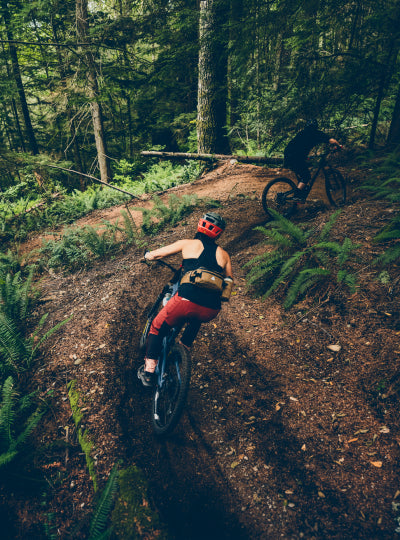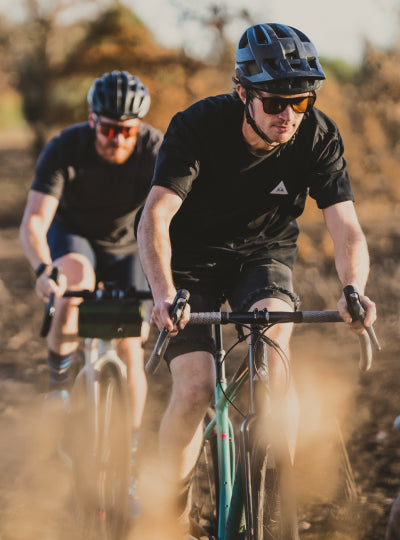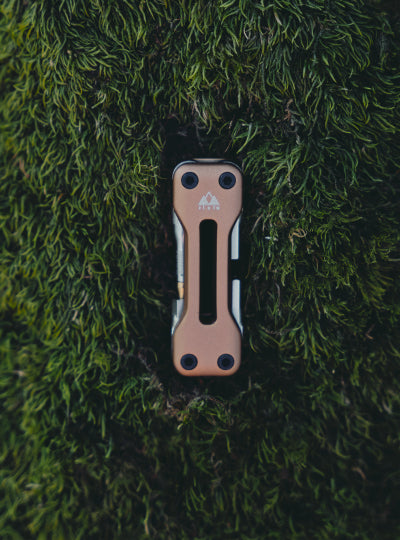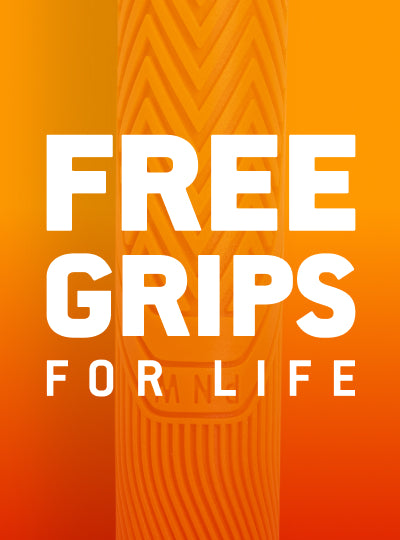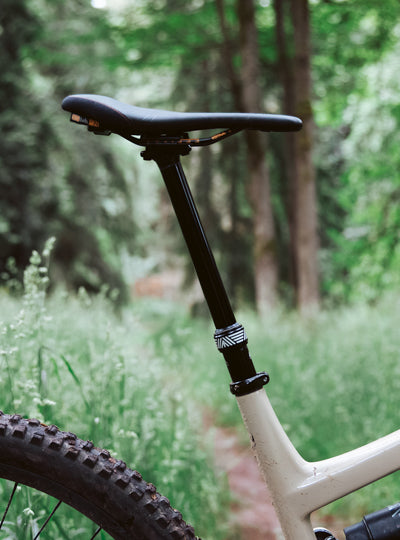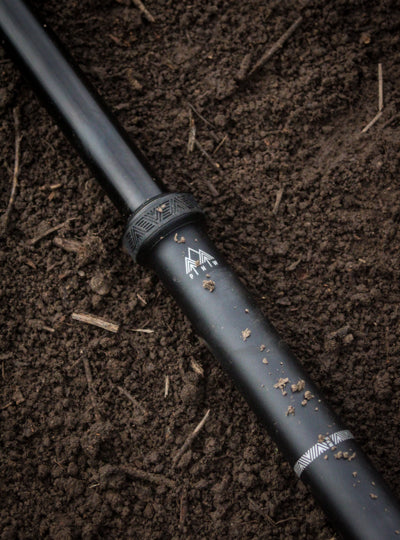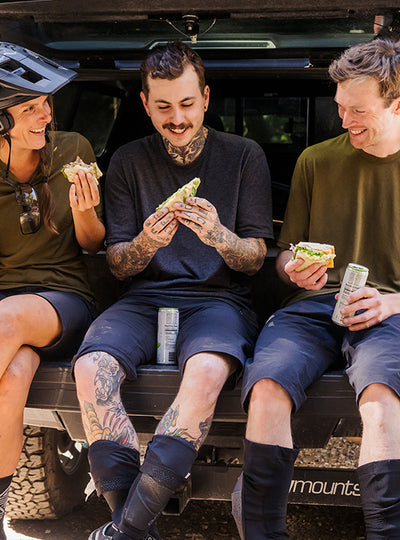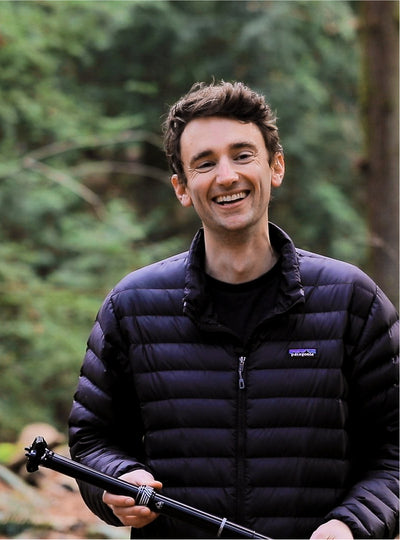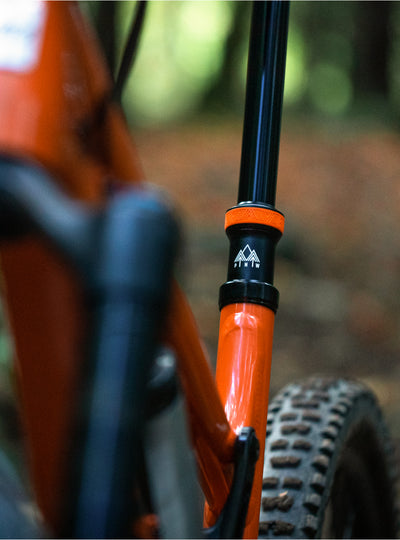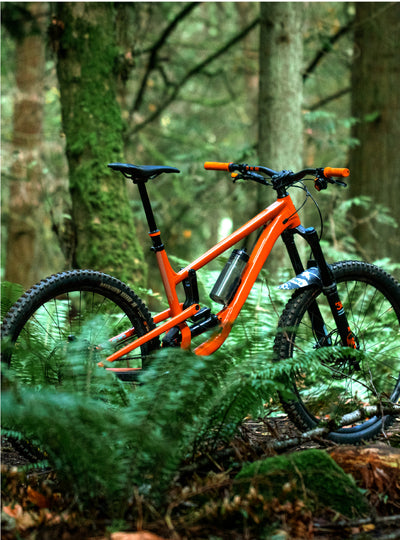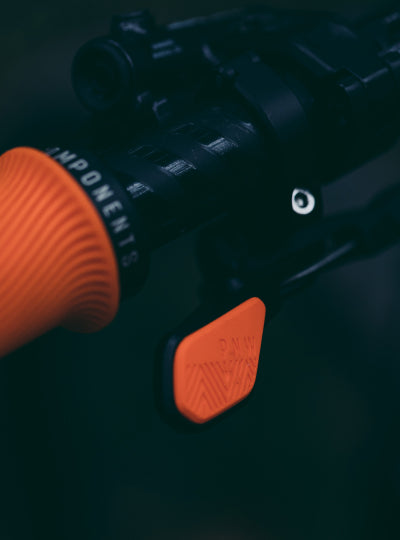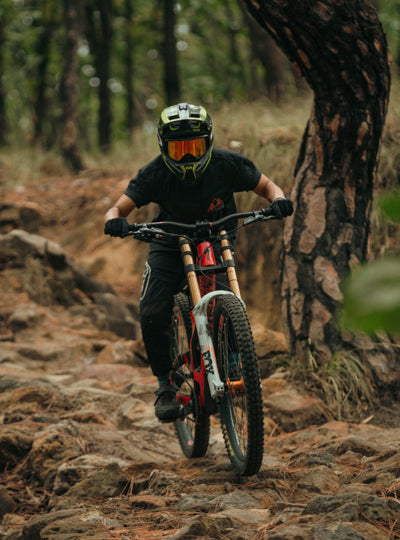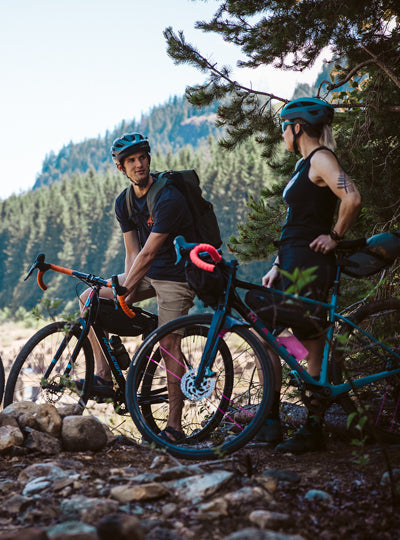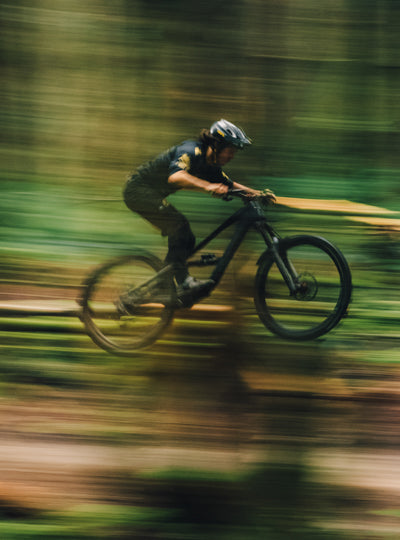We’ll be honest, making new bike parts is extremely fun, but it is also super nerdy and hella scientific. It has been a couple of months since we launched the Loam Carbon Bar, and we thought it was time to sit down with our product team and get their deep dive into the development process of the Loam. Like a lot of our components, it all starts with listening to our customers, followed by hours upon hours of ride testing and development.
Not to toot our own horn too much, but we’re super stoked with the results. We hope you’ve been out riding a Loam Carbon Bar, and if not, maybe our favorite bike nerds can convince you. Read on for a chat with PNW Director of Product, Todd Ford & Product Manager, TJ Trotter. Or just tune in and listen to us get nerdy and discover the true meaning of Krispy Kreme carbon fiber.
"We were focused on what we can do to make a proper high-performance mountain bike bar that's not going to break the bank too."
WHY CARBON?
Why would we make a carbon handlebar when we already had so much success with the Range? Why did we choose carbon?
Todd Ford: We wanted to highlight what you can do with carbon. You know, we've been a bit of an expert when it comes to making aluminum handlebars. We know how they operate. We know what they do, what they do well, and what we really wanted to do with the carbon bar was kind of take our knowledge of geo and of that material and then translate it into this new carbon bar. So we really were focused on what can we do to make a proper like high performance mountain bike bar that's not going to break the bank too.
TJ Trotter: The biggest thing I would say is customers kept asking for a carbon handlebar, with the same ergonomic story as the Range, our alloy handlebar. We made a really phenomenal bar with the Range Alloy Bar. We have more backsweep than a lot of the traditional mountain bike handlebars at 10 degrees back versus 8 or 9. And people have found that it's super comfortable. So they wanted that geometry, but in carbon, and we decided to go for it.
What were you trying to improve on over the options that were already out there?
Todd Ford: We wanted to make sure that what we were gonna do had a significant point of view, and for us, that point of view has always been special with our bars, it is about comfort and performance - comfort on the bike, comfort for your wrists and your overall position on the bike, and we wanted to carry that story through with a good material story as well.
Compared to what our competitors were doing. Was there anything specific we were trying to improve on?
Todd Ford: We really wanted to make a bar that's going to be compliant and really predictable. You know, our main objectives were compliance, steering, handling, essentially.
"We did our best to make data-driven decisions as much as we could in the development process."
RIDE TESTING THE COMPETITION
How were our competitors bar tested and compared? How did that help us figure out what we can do to take this to the next level?
TJ Trotter: We started with ride testing. We tested six different handlebars from competitors in what I would argue, some of the best testing locations in North America, the Pacific Northwest, Western, North Carolina, and Santa Cruz, California. We rode all the bars several times on the same test tracks to where we could just get really comfortable, and speak to the different ride-feel characteristics of each bar. Whether it was not very predictable, whether it was harsh, or whether it was really comfortable in some areas, or unforgiving in others.
So bikes, grips, tires, all the contact points on the bike are the same. By doing that, we got really comfortable and really confident speaking to the different riding characteristics of the different handlebars. This was the first step in the process, collecting that initial competitor data.
So your job was to just ride your bike over and over and over again on the same trails?
Todd Ford: Yeah. Yep.
You guys have it so rough.
Todd Ford: It's a tough job.
To TJ's point, we made it very strict to ride the same exact trail. You ride the exact same setup. Don't change your tire pressures, don't change your suspension setup. Nothing changes except for the handlebars.
So we were literally doing laps. You'd finish a run, swap your handlebars out, go up, and do it again. And it was really interesting doing back-to-back riding like that because you start to notice nuances of each and every bar as you are doing it. What was really interesting was both TJ and I got very similar feelings with competitor bars when we compared our notes. Bars that are touted as very comfortable AND very compliant, tend to have this unpredictable feeling. It wasn't until we were doing back-to-back rides on the same trail on the same bike with the same setup, that all of a sudden, you're feeling this odd vagueness in the front end. On the run before, you nailed that berm perfectly, you hit that g out and it was fine - but for some reason this time it didn't hit the same way and you're trying to understand what it was by talking it through and kind of reflecting back on how the ride was. We both realized that it was this unpredictable handling situation that lead to a decrease in bike handling control - I mean, it's not a great feeling when your front end and front wheels are going a different direction than…where your bars are. We wanted to solve that.
TJ Trotter: Yeah, when you rode the same bike, with the same setup, on the same trail, on the same day, but you're swapping handlebars, you consistently can feel yourself getting more or less sketchy in certain areas.
Once we got a really good feel for it, we sent all of those handlebars that we had already ride-tested to a lab to measure their deflection in two different directions. This is what we are referring to when we talk about horizontal and vertical deflection. So by testing them, we were able to correlate real data to our ride experiences on the handlebars. Then, we could say that a bar with x-millimeters of deflection feels like this when you're riding it. And that's how we tested the best of the bars we had ridden.
"What you see in that green area is the PNW bar. It's increased comfort and increased predictability by reducing the horizontal compliance and increasing the vertical compliance compared to competitors."
THE PROOF IS IN THE DEFLECTION DATA
Can you explain the data-vis graph and what we did in testing to conclude that we did improve upon our top competitors' bars? It's one of those things that just might look like we're tooting our own horn, but I know that it is data-based, so I just want to hear what the deal is with this cute little graph we made.
TJ Trotter: We gathered all this different subjective data, and mapped it to the deflection data. You know, some of our competitor bars were a little bit softer, some were more comfortable, some were really rigid etc… this is how we quantified how the bar feels, and we did this deflection testing on all the bars that we rode, and then when we developed ours, ran it through this same process to see where it landed.
What you're looking at on this graph is the vertical axis, which represents comfort, and the horizontal axis, which represents predictability. When you think about your handlebar bending or deflecting vertically that is what is creating more or less comfort, and as it bends or deflects horizontally that is how predictable the bar is going to be.
If you can, imagine the handlebars in a stem, we measured how far they bend up and down. And then we rotated them forward 90 degrees, hung a weight on the end of the bar and measured how far they deflected side to side. So by doing that we were able to collect actual data, millimeters of deflection vertically and horizontally.
What we found is that other handlebars, they might deflect one way really well which translates to a predictable ride field, but in turn they're harsh to ride. Or they're really comfortable, but they don't necessarily point your wheel where you want it to go... So what we were able to do was create a bar that deflects our preferred amount of vertical deflection combined with horizontal. And that's what you see in that green area, the PNW bar. It's increased comfort and increased predictability by reducing horizontal compliance and then increasing the vertical compliance compared to competitors. So the wheel points wherever you point the handlebars, and then on the vertical axis, it's hitting horizontal deflection numbers that translate to a really comfortable ride. So the challenge was to find that perfect balance and we feel like we hit the nail on the head.
"It just really confirmed that all of our feelings in the ride testing matched the data and that was a very exciting moment."
THE BREAKTHROUGH
How did we get the deflection data that's in this data visualization?
Todd Ford: So once we determined that we really wanted to figure out this whole vertical versus horizontal compliance deflection deal, we worked with our engineer to create a pretty sweet little test rig.
As TJ said earlier, we bend the bar at a specific angle with a certain amount of weight at a precise location on the bar, both vertically and horizontally, and that determines where our values are. So we did that with all of our competitor bars. Then once we got our sample bars, we started doing that as well just to validate that the bars were, performing the way that we wanted them to.
It was really cool and it's a pretty unique feature to have this kind of test protocol now that we have. We have a rig right in our warehouse now, so we can do the testing any time we want with any bars that we want. We can cut a bar to 760, see how it performs. Any bar that comes in, we can test it and see what's going on with it.
It's a pretty proprietary testing that we developed. And again, it's been pretty amazing how the testing in the lab really correlates to what we felt in real life.
When we got our first samples of the bars, we actually tested two different versions of it. What we were doing is we were modifying the shape and orientation of the CBD inside, so we wanted to see how it was operating, what it was doing, and if we could tell the difference. So we did some blind testing with it. We got two different versions of the bar. We did not know which one was which, we just wrote it and then came back to our engineer and really this is what we're feeling, this one compared to this one.
And it was a wild card. He's like, Wow, you guys got it right. That's exactly what we saw in the lab. It's doing exactly what you're saying. So again, it just kind of validated that, you know, what we were feeling and what were seeing in testing made sense.
TJ Trotter:
I want to just add to that story, we got quite a few of those samples, the two different versions, and we shipped them all over the world. We had someone in Arkansas riding it. We had someone in the UK riding it. We had them all over the US. And as Todd said, our engineer told us before we started testing those versions that one of them was a little bit closer to our ideal of deflection numbers and everyone that rode the bars agreed that one of them was a little bit better than the other, and that matched what our engineer told us was going to be like a little bit closer to our ideal numbers.
It just really confirmed that all of our all of our feelings in the ride testing matched the data and that was that. That was a very exciting moment.
Todd Ford: It was a breakthrough.
TJ Trotter: It was really kind of a pragmatic approach, like, what do we love about competitors and how can we, you know, what do we not like? And then how can we change our bar to to get the best of both worlds?
"It was pretty surprising how much it was like a 1 to 1 of what we're feeling on the trail and how we can correlate that to our deflection data."
FEA ANALYSIS
Once you had tested all the competitors’ bars, how did we we figure out how to get to this point on this graph? How did we find this point of comfort and predictability once we had the tests done?
Todd Ford: It was pretty surprising how much it was a 1 to 1 of what we're feeling on the trail and how we can correlate that exactly to our deflection data. And basically, we just took that information to create our targets. So we knew in this scenario, this bar, this bar felt really good right here going through a rocky and chunky section. We like the way that it felt. But when we hit this hard g-out or this berm, the front end was all over the place. We don't like that. But on this other bar, we really liked the way that that felt in this tight corner or something. So we could take the numbers and say, right, we like that much deflection vertically. We like that much horizontally.
We brought that to our engineer and he, as he built out the 3D model for the bar, he was actually able to use what's called FEA analysis to apply a force, on the computer, and see how the bar is going to bend. So we use those targets to try to get that deflection and that's how we created our internal structure.
So it hit exactly where those targets are going to be, both vertically and horizontally in real life.
"We optimized the wall thickness of the handlebar to deflect exactly how we wanted it to"
WHAT'S IN THE CBD?!
Then at that point, is that when our patent pending CBD lab was developed, what is CBD? What's inside here that makes this so special?
TJ Trotter: Yeah, so CBD is our Compliant Bore Design (layup), and basically what we did is, we optimized the wall thickness of the handlebar to deflect exactly how we wanted it to. So in doing that, we were able to place different carbon sheets in different areas of the bar. We were even able to determine the orientation of those carbon sheets to predetermine the wall thickness in the handlebar.
So it's a variable wall thickness bar and basically, that is the Compliant Bore Design (layup).
Todd Ford: And you've seen other brands kind of do similar where they do an external shaping. You know, there's some out there that have like an interesting oval shape and on the outside of the bar, which they use to kind of create this compliant design with ours, everything's internal.
And a big piece of that is how we can hold tolerances for our wall thicknesses inside the bar that allows us to do this.
"EPS Molding allows us to have super tight tolerances for our wall thicknesses and land our carbon where we want it to be"
A DIFFERENT KIND OF MOLD
For the CBD layup, how do you get it to be consistent, so that you can know that the wall thickness is where you want it to be and it's all laying correctly?
Todd Ford: We have partnered with a very fantastic manufacturer and they use what's called EPS molding. It's relatively new to the bike industry, it's a form of carbon layup design. When you lay up a carbon, anything, what you do is you have an internal mold structure that you then layer your layers of carbon on top of you put it inside a gigantic mold, put it in an oven, you bake it, and that's how you create a carbon, anything.
What EPS molding is, is a kind of like foam internal mold that you're wrapping around. And then when you apply heat to it, it expands. It creates a ton of pressure inside. So as it's baking inside the oven, you have this internal pressure going up against the walls inside the bar and then obviously a big metal tool that it's sitting in.
So it's compressing those carbon sheets exactly where you want it in the exact orientation that you want. It allows us to have super tight tolerances for our wall thicknesses and land our carbon where we want it to be. If you've ever seen the inside of like a carbon fiber frame, sometimes it looks like strands of hair and kind of all gunky and sh*tty looking.
Yeah. So basically, the molding process really allows us to do CBD properly and refine and hit the exact numbers that we're looking for for our compliance.
"Our carbon is essentially Krispy Kreme with the donut sign on. Fresh, ready to go."
BAKED ON PREMISES
What type of carbon do we use for the Loam Carbon Bar, and why did we choose that carbon?
TJ Trotter: We use unidirectional carbon and by using that type of carbon, it helped us determine how the bar would run.
So using FEA analysis and using that type of carbon, we can place the carbon sheets in very specific locations on a bar that helps us determine the thickness of the bar in that location, but also, depending on which direction the carbon fibers are facing, that also kind of determines how the bar will deflect as well.
So by using unidirectional carbon, we were able to fine-tune how the bar rides.
Todd Ford: The other cool thing again with our fantastic manufacturing partner is their ability to lay up carbon.
Often with carbon manufacturers, they just bring in a preprogram, which is a pre-impregnated carbon, meaning it already has resin kind of baked into it, but with our vendor that we work with, they actually can lay out their carbon. They take these huge rolls of carbon fibers that are on lake reels. They can shoot it through this machine, pick exactly which carbon they want, and then they can pre-preg it right there so they can choose carbon that they want, and the resins that they want.
So it's pretty amazing that we have this ability to fine tune exactly what carbon we want for the bar and nail exactly what we want the bar to do performance-wise.
TJ Trotter: One note just to add about that is once carbon is impregnated with, it's with the resin. There's a pretty short shelf life.
Todd Ford: So for our factory to be able to do that on an as-needed basis, it just ensures that we're always using really high-quality carbon that's ripe and it's not going to go bad or anything like that. So it's really, really nice factory to work with.
Do you know those old-fashioned diners that have signs that say “baked on-premises”? They make that claim about their pies? Well, we have carbon that’s “baked on-premises.”
Todd Ford: Yeah, our carbon is essentially Krispy Kreme with the donut sign on. Fresh, ready to go.
Another thing I will mention, while it is a full, unidirectional carbon bar, at the very ends of the bars, it's actually a 3k weave. And we did that on purpose so that when you cut your bar down, if you want to trim it down because it's an 800, if you want to go down to like 760, when you cut it, because it's a 3k weave there at the ends, it won't fray or anything, it'll create a cleaner cut. So you just have less risk of shards of carbon etc.
"Anyone can make a handlebar and they don't technically have to test it to the ISO standard, which is terrifying. We were not going to do that."
STRENGTH TESTED TO THE MAX
We have this whole other side of manufacturing this carbon bar that I know you guys take really seriously. Some riders are going to have apprehensions about riding a carbon fiber handlebar going down gnarly terrain. So what can you tell me about the strength testing that we did for the Loam carbon bar? How do we know that it's safe to hook yourself off some scary sh*t with this handlebar?
Todd Ford: There is some testing protocol within the bike industry called ISO 4210. It's the industry standard for all bike testing and within that they have specific testing associated to handlebars. So that's like step one. But to be honest, brands don't even have to do that... which is wild. Anyone can make a handlebar and they don't technically have to test it to the ISO standard, which is terrifying.
We were obviously not going to do that. So we decided that on top of the standard ISO testing we would work with another third-party lab called EFBE. They are a pretty big test house. They have testing facilities all over the world and they have developed their own level of testing that's an addition to ISO.
There are the ISO tests, and then EFBE has several categories that go above ISO depending on what your goal is, and what your category is for your handlebar. So for us, what we decided is we wanted this thing to be super strong. We wanted to make sure there were no issues. So we tested it to what they call their category five level, which is for downhill standard and e-MTB.
It's their highest standard as far as testing goes. The way you do the test, it's a fatigue test and a max load test. So basically they run a bunch of cycles on the bar, and make sure that it doesn't crack or give in anyway to the pressure. And then they run a max load. After doing the fatigue test, and the max load test as well, our bars passed with no issue, which is very cool.
"We spent a lot of time on the packaging. We wanted a recyclable option that would reduce the amount of cardboard that we currently use with the Range Bar"
BACKYARD COMPOSTABLE
Is there anything else about the Loam Carbon Bar that's unique that you guys want to talk about or let people know, that maybe we don't necessarily hammer home in our marketing materials, but you guys know because you were there every step of the way?
TJ Trotter: I'd like to talk about the packaging real quick. We wanted a recyclable option that would reduce the amount of cardboard that we currently saw on the Range Handlebar. We've always strived to be plastic-free where we can. For handlebars this means we've always used cardboard.
But then the question came like, how do we use even less cardboard? So we were talking for a long time about using some kind of custom paper envelope or a cardboard envelope that would reduce the amount of cardboard from a box. But we did a lot of research and we found out that 95% of the shipments that we send out for handlebars also include another product.
So we're putting the handlebar in the box, inside another box with the other product. When we saw these numbers we realized that it just makes more sense to create a compostable bag. The cool thing about the compostable bag is it's backyard compostable. You can put it right in your green waste bin, or your compost. It's not fake composable and it's not industrial compostable – there are industrial compostable bags out there that if they go into a landfill, they can still can take hundreds of years to decompose. So this one you can put right in your compost bin and it'll decompose. I have a couple of them in my compost bin and after a few months, it's hard to tell what's what when you're digging around with a shovel, but there's not much left in there.
